TOYOTA PRIUS PLUG-IN 2014 Owners Manual
Manufacturer: TOYOTA, Model Year: 2014, Model line: PRIUS PLUG-IN, Model: TOYOTA PRIUS PLUG-IN 2014Pages: 724, PDF Size: 20.28 MB
Page 621 of 724
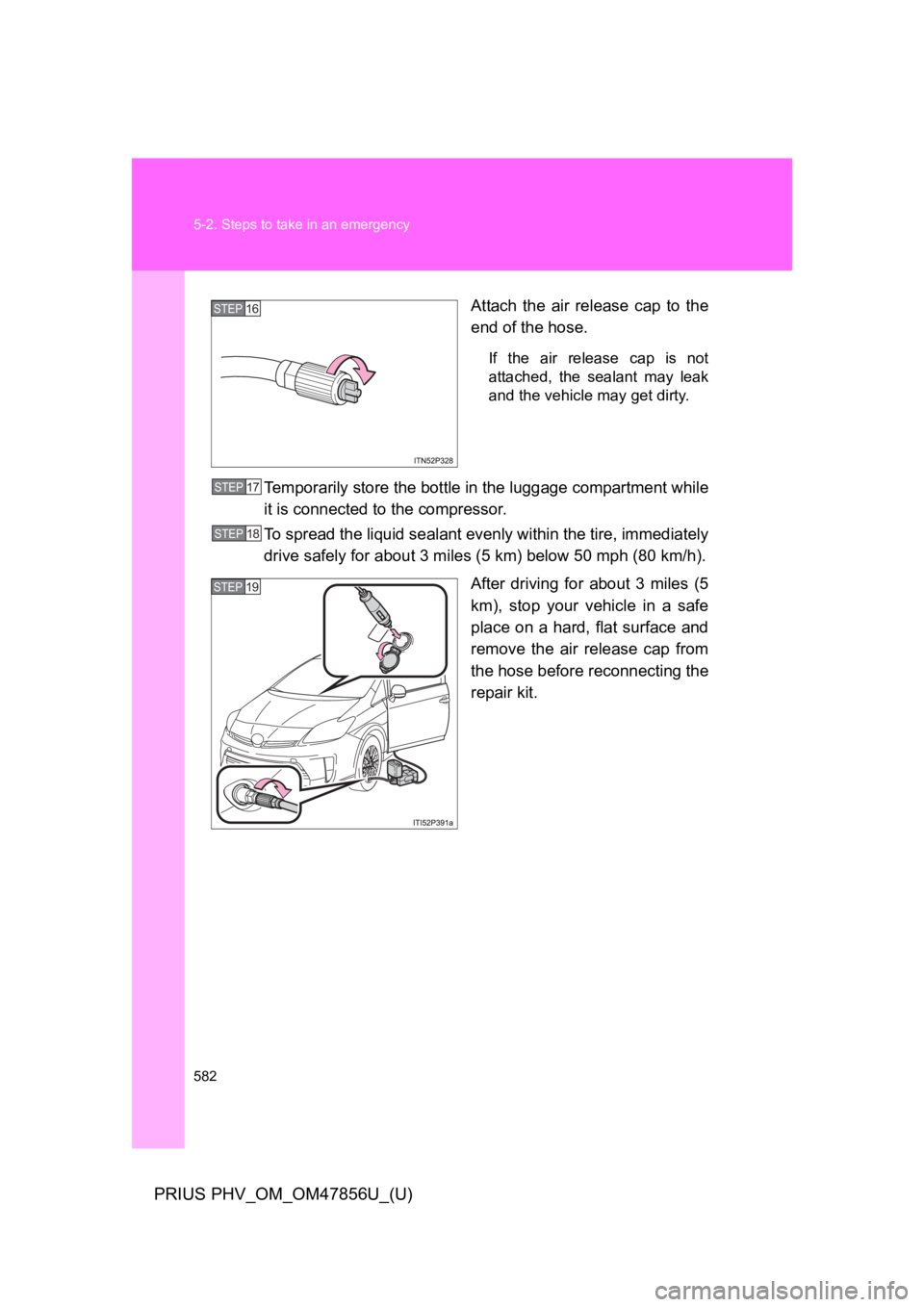
582
5-2. Steps to take in an emergency
PRIUS PHV_OM_OM47856U_(U)
Attach the air release cap to the
end of the hose.
If the air release cap is not
attached, the sealant may leak
and the vehicle may get dirty.
Te m p o r a r i l y s t o r e t h e b o t t l e i n t h e l u g g a g e c o m p a r t m e n t w h i l e
it is connected to the compressor.
To s p r e a d t h e l i q u i d s e a l a n t e v e n ly within the tire, immediately
drive safely for about 3 miles (5 km) below 50 mph (80 km/h).
After driving for about 3 miles (5
km), stop your vehicle in a safe
place on a hard, flat surface and
remove the air release cap from
the hose before reconnecting the
repair kit.
STEP16
STEP17
STEP18
STEP19
Page 622 of 724
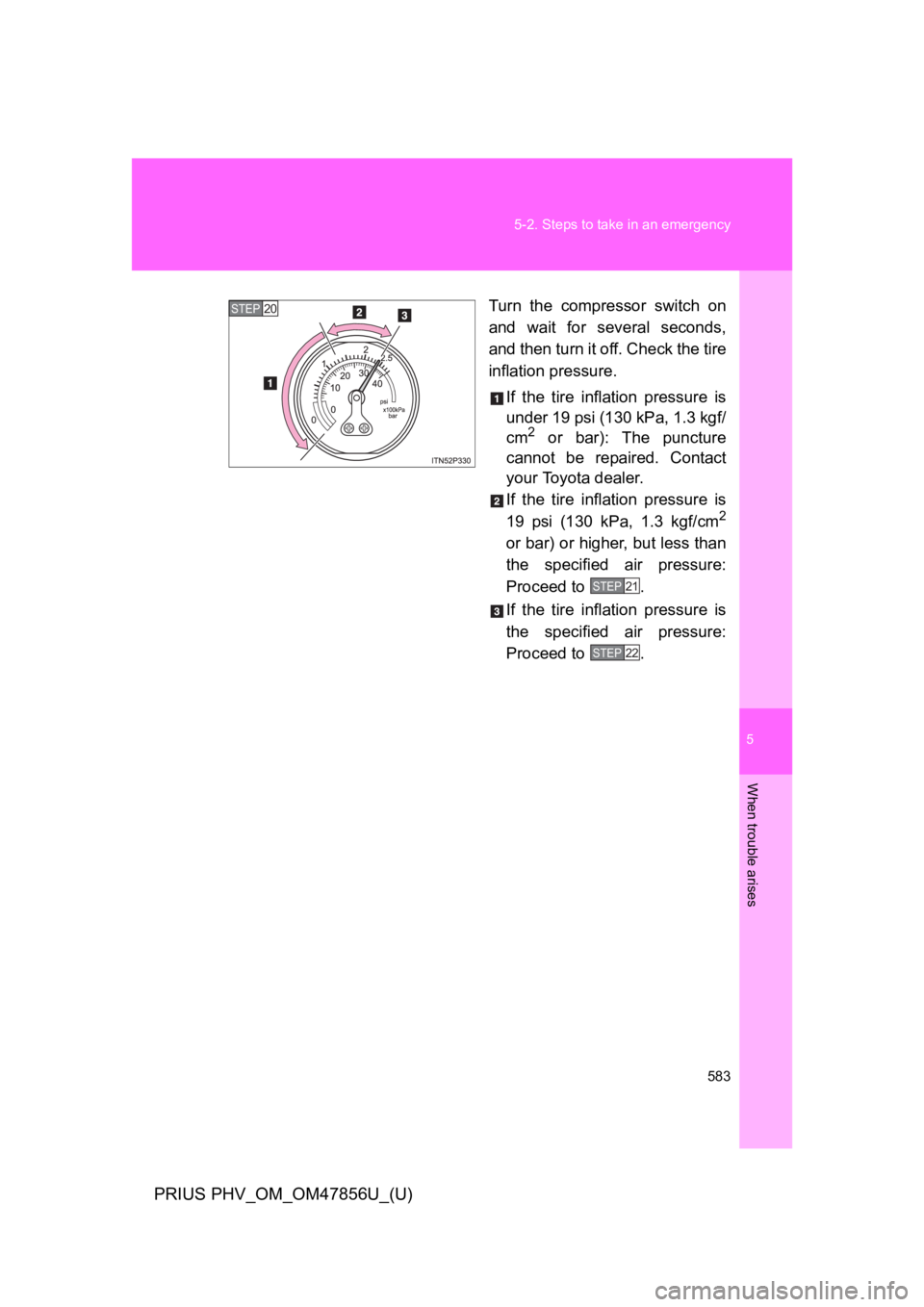
5
When trouble arises
583
5-2. Steps to take in an emergency
PRIUS PHV_OM_OM47856U_(U)
Turn the compressor switch on
and wait for several seconds,
and then turn it off. Check the tire
inflation pressure.
If the tire inflation pressure is
under 19 psi (130 kPa, 1.3 kgf/
cm2 or bar): The puncture
cannot be repaired. Contact
your Toyota dealer.
If the tire inflation pressure is
19 psi (130 kPa, 1.3 kgf/cm2
or bar) or higher, but less than
the specified air pressure:
Proceed to .
If the tire inflation pressure is
the specified air pressure:
Proceed to .
STEP20
STEP21
STEP22
Page 623 of 724
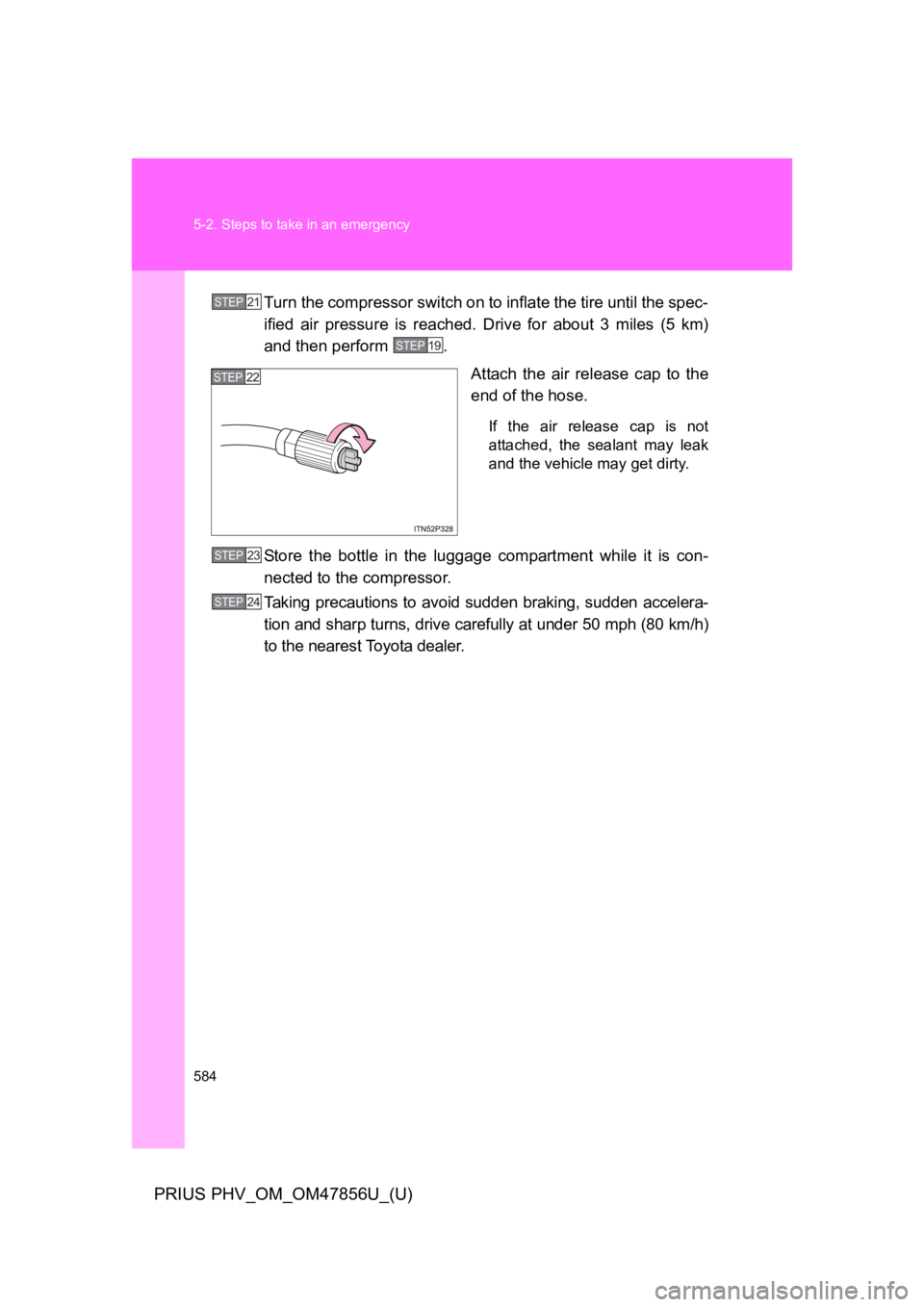
584
5-2. Steps to take in an emergency
PRIUS PHV_OM_OM47856U_(U)
Turn the compressor switch on to inflate the tire until the spec-
ified air pressure is reached. Drive for about 3 miles (5 km)
and then perform .
Attach the air release cap to the
end of the hose.
If the air release cap is not
attached, the sealant may leak
and the vehicle may get dirty.
St ore the b ottle in the lugg age compartment while it is con-
nected to the compressor.
Ta k i n g p r e c a u t i o n s t o a v o i d s u d d e n b r a k i n g , s u d d e n a c c e l e r a -
tion and sharp turns, drive carefully at under 50 mph (80 km/h)
to the nearest Toyota dealer.
STEP21
STEP19
STEP22
STEP23
STEP24
Page 624 of 724
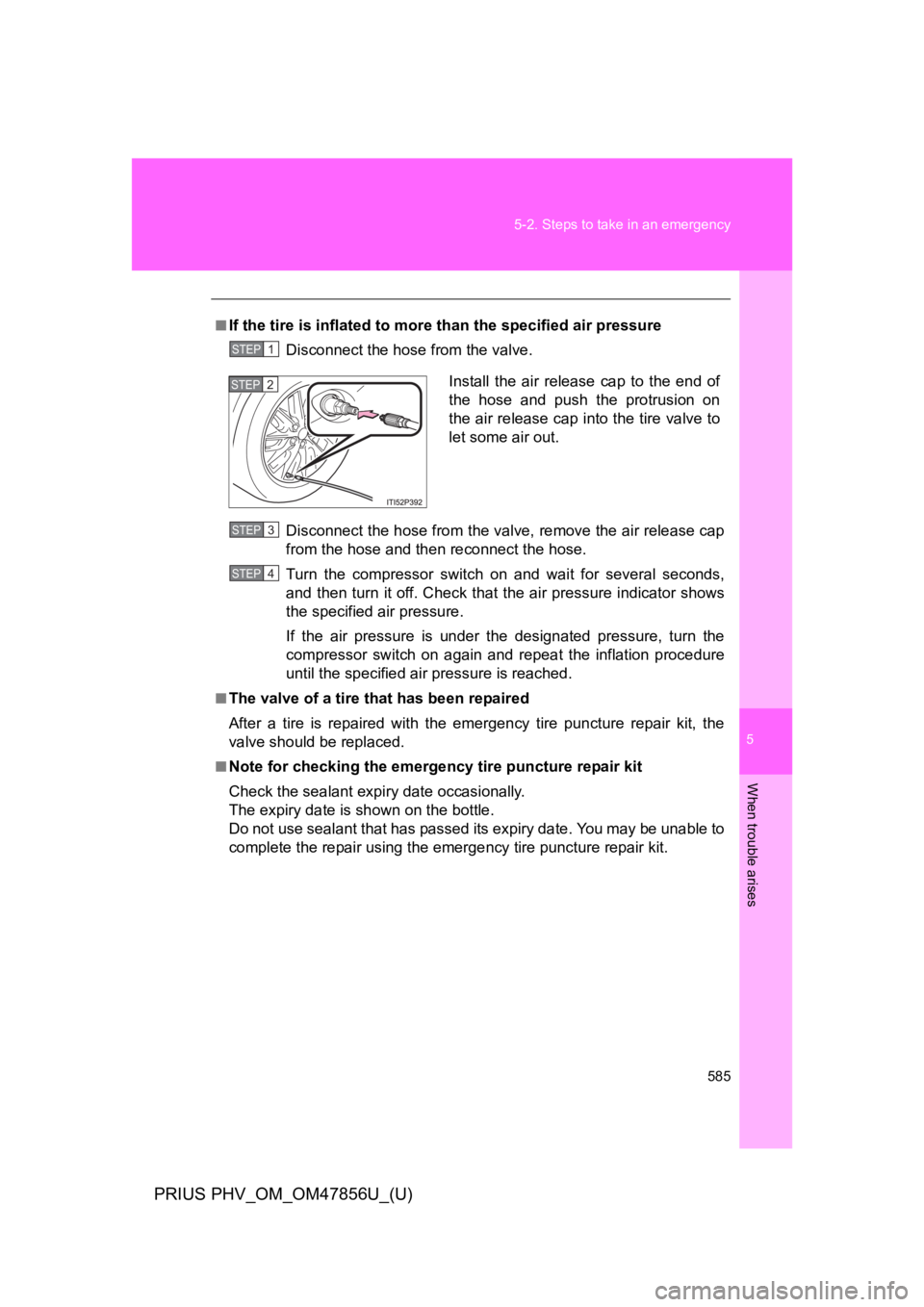
5
When trouble arises
585
5-2. Steps to take in an emergency
PRIUS PHV_OM_OM47856U_(U)
■If the tire is inflated to more than the specified air pressure
Disconnect the hose from the valve.
Disconnect the hose from the valve, remove the air release cap
from the hose and then reconnect the hose.
Turn the compressor switch on and wait for several seconds,
and then turn it off. Check that the air pressure indicator shows
the specified air pressure.
If the air pressure is under the designated pressure, turn the
compressor switch on again and repeat the inflation procedure
until the specified air pressure is reached.
■The valve of a tire that has been repaired
After a tire is repaired with the emergency tire puncture repair kit, the
valve should be replaced.
■Note for checking the emergency tire puncture repair kit
Check the sealant expiry date occasionally.
The expiry date is shown on the bottle.
Do not use sealant that has passed its expiry date. You may be unable to
complete the repair using the emergency tire puncture repair kit.
STEP 1
Install the air release cap to the end of
the hose and push the protrusion on
the air release cap into the tire valve to
let some air out.
STEP 2
STEP 3
STEP 4
Page 625 of 724

586
5-2. Steps to take in an emergency
PRIUS PHV_OM_OM47856U_(U)
■Emergency tire puncture repair kit
●The sealant stored in the emergency tire puncture repair kit can be
used only once to temporarily repair a single tire. If the sealant has
been used and needs to be purchased, contact your Toyota dealer.
●The sealant can be used when the outside temperature is from -40°F
(-40°C) to 140°F (60°C).
●The repair kit is exclusively designed for size and type of tires origi-
nally installed on your vehicle. Do not use it for tires that a different
size than the original ones, or for any other purposes.
●The sealant has a limited lifespan. The expiry date is shown on the
bottle. The sealant should be replaced before the expiry date. Con-
tact your Toyota dealer.
●If the sealant gets on your clothes, it may stain.
●If the sealant adheres to a wheel or the surface of the vehicle body,
the stain may not be removable if it is not cleaned at once. Immedi-
ately wipe away the sealant with a wet cloth.
●During operation of the repair kit, a loud operation noise is produced.
This does not indicate a malfunction.
●Do not use to check or to adjust the tire pressure.
Page 626 of 724

5
When trouble arises
587
5-2. Steps to take in an emergency
PRIUS PHV_OM_OM47856U_(U)
CAUTION
■Do not drive the vehicle with a flat tire
Do not continue driving with a flat tire.
Driving even a short distance with a flat tire can damage the tire and the
wheel beyond repair.
Driving with a flat tire may cause a circumferential groove on the side
wall. In such a case, the tire may explode when using a repair kit.
■Caution while driving
●Store the re pa ir kit in the luggage compartmen t.
Injuries may result in the event of an accident or sudden braking.
●The repair kit is exclusively only for your vehicle.
Do not use repair kit on other vehicles, which could lead to an accident
causing death or serious injury.
●Do not use repair kit for tires that are different size than the original
ones, or for any other purpose. If the tires have not been completely
repaired, it could lead to an accident causing death or serious injury.
■Precautions for use of the sealant
●Ingesting the sealant is hazardous to your health. If you ingest sealant,
consume as much water as possible, and then immediately consult a
doctor.
●If sealant gets in eyes or adheres to skin, immediately wash it off with
water. If discomfort persists, consult a doctor.
Page 627 of 724

588
5-2. Steps to take in an emergency
PRIUS PHV_OM_OM47856U_(U)
CAUTION
■When fixing the flat tire
●Stop your vehicle in a safe and flat area.
●Do not touch the wheels or the area around the brakes immediately
after the vehicle has been driven.
After the vehicle has been driven, the wheels and the area around the
brakes may be extremely hot. Touching these areas with hands, feet or
other body parts may result in burns.
●Connect the valve and hose securely with the tire installed on the vehi-
cle. If the hose is not properly connected to the valve, air leakage may
occur as sealant may be sprayed out.
●If the hose comes off the valve while inflating the tire, there is a risk
that the hose will move abruptly due to air pressure.
●After inflation of the tire has completed, the sealant may splatter when
the hose is disconnected or some air is let out of the tire.
●Follow the operation procedure to repair the tire. If the procedures not
followed, the sealant may spray out.
●Keep back from the tire while it is being repaired, as there is a chance
of it bursting while the repair operation is being performed. If you
notice any cracks or deformation of the tire, turn off the compressor
switch and stop the repair operation immediately.
Page 628 of 724

5
When trouble arises
589
5-2. Steps to take in an emergency
PRIUS PHV_OM_OM47856U_(U)
CAUTION
●The repair kit may overheat if operated for a long period of time. Do not
operate the repair kit continuously for more than 60 minutes.
●Parts of the repair kit become hot during operation. Be careful handling
the repair kit during and after operation. Do not touch the metal part
connecting the bottle and the compressor. It will be extremely hot.
●Do not attach the vehicle speed warning sticker to an area other than
the one indicated. If the sticker is attached to an area where an SRS
airbag is located, such as the pad of the steering wheel, it may prevent
the SRS airbag from operating properly.
■Driving to spread the liquid sealant evenly
Observe the following precautions to reduce the risk of accidents.
Failing to do so may result in a loss of vehicle control and cause death or
serious injury.
●Drive the vehicle carefully at a low speed. Be especially careful when
turning and cornering.
●If the vehicle does not drive straight or you feel a pull through the
steering wheel, stop the vehicle and check the following.
•Tire condition. The tire may have separated from the wheel.
• Tire inflation pressure. If the tire inflation pressure is 19 psi (130
kPa, 1.3 kgf/cm2 or bar) or less, the tire may be severely damaged.
Page 629 of 724

590
5-2. Steps to take in an emergency
PRIUS PHV_OM_OM47856U_(U)
NOTICE
■When performing an emergency repair
●A tire should only be repaired with the emergency tire puncture repair
kit if the damage is caused by a sharp object such as nail or screw
passing through the tire tread.
Do not remove the sharp object from the tire. Removing the object may
widen the opening and disenable emergency repair with the repair kit.
●The repair kit is not waterproof. Make sure that the repair kit is not
exposed to water, such as when it is being used in the rain.
●Do not put the repair kit directly onto dusty ground such as sand at the
side of the road. If the repair kit vacuums up dust etc., a malfunction
may occur.
■Precautions for the emergency tire puncture repair kit
●The repair kit power source should be 12 V DC suitable for vehicle
use. Do not connect the repair kit to any other source.
●If gasoline splatters on the repair kit, the repair kit may deteriorate.
Ta k e c a r e n o t t o a l l o w gasoline to contact it.
●Place the repair kit in a storage to prevent it from being exposed to dirt
or water.
●Store the re pa ir kit in the luggage compartment ou t of reach of chil-
dren.
●Do not disassemble or modify the repair kit. Do not subject parts such
as the air pressure indicator to impacts. This may cause a malfunction.
■To a v o i d d a m a g e t o t h e t i r e p r e s s u r e w a r n i n g v a l v e s a n d t r a n s m i t -
ters
When a tire is repaired with liquid sealants, the tire pressure warning
valve and transmitter may not operate properly. If a liquid sealant is
used, contact your Toyota dealer or other qualified service shop as soon
as possible. Make sure to replace the tire pressure warning valve and
transmitter when replacing the tire. (→P. 4 8 0 )
Page 630 of 724
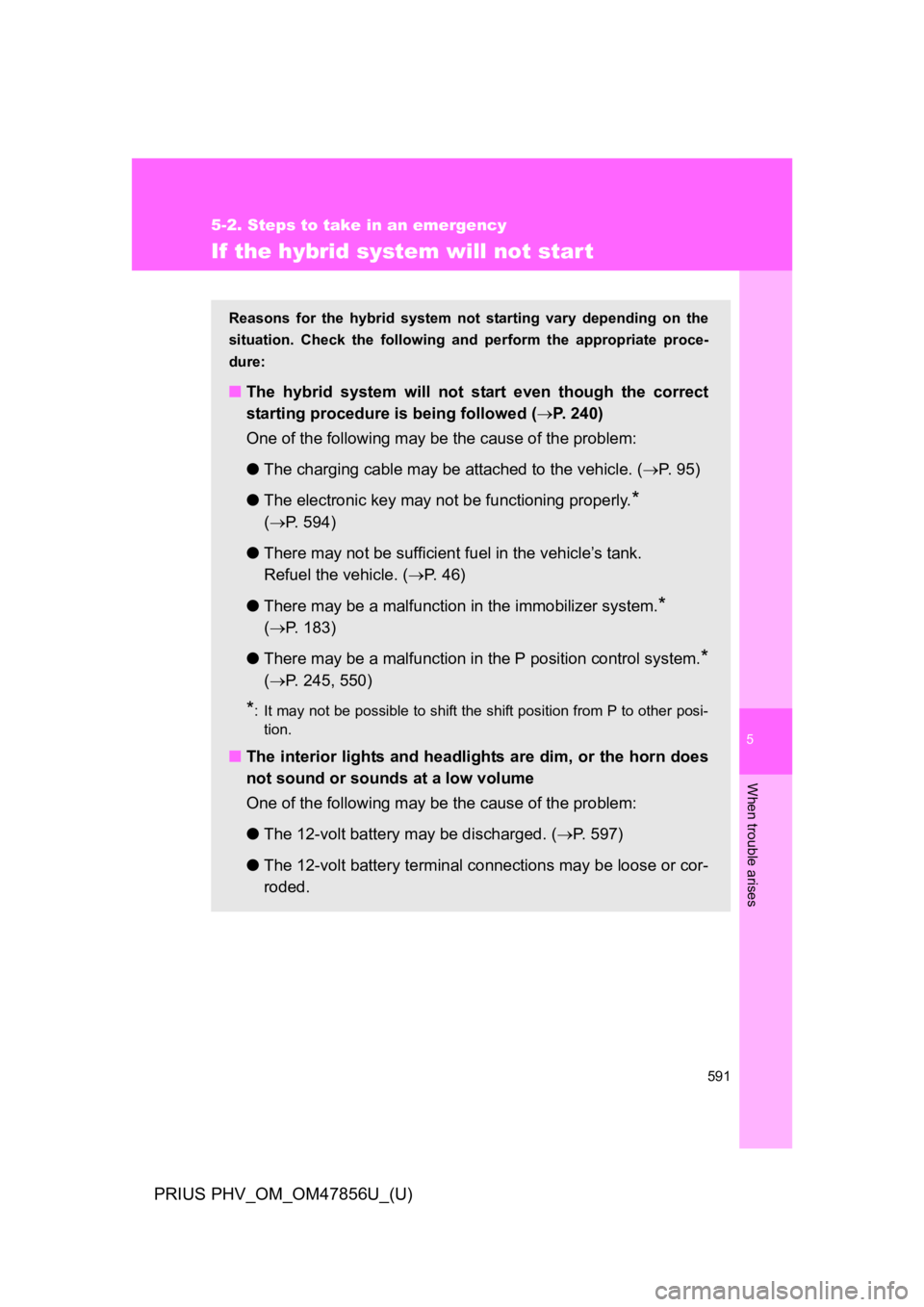
5
When trouble arises
591
5-2. Steps to take in an emergency
PRIUS PHV_OM_OM47856U_(U)
If the hybrid system will not start
Reasons for the hybrid system not starting vary depending on the
situation. Check the following and perform the appropriate proce-
dure:
■The hybrid system will not start even though the correct
starting procedure is being followed (→P. 2 4 0 )
One of the following may be the cause of the problem:
●The charging cable may be attached to the vehicle. (→P. 9 5 )
●The electronic key may not be functioning properly.*
(→P. 5 9 4 )
●There may not be sufficient fuel in the vehicle’s tank.
Refuel the vehicle. (→P. 4 6 )
●There may be a malfunction in the immobilizer system.*
(→P. 1 8 3 )
●There may be a malfunction in the P position control system.*
(→P. 2 4 5 , 5 5 0 )
*:It may not be possible to shift the shift position from P to other posi-
tion.
■The interior lights and headlights are dim, or the horn does
not sound or sounds at a low volume
One of the following may be the cause of the problem:
●The 12-volt battery may be discharged. (→P. 5 9 7 )
●The 12-volt battery terminal connections may be loose or cor-
roded.